Enshrouded in the allure of the wild Alaskan wilderness, a symphony of owls takes to the twilight skies. Their piercing hoots echo through the stillness, carving an intriguing narrative of life in Alaska’s shadowy nightscapes.
Our journey explores the lives of 10 fascinating owl species that call Alaska their home, shedding light on their unique behaviours, adaptations, and roles within the ecological tapestry of this beautiful state. Settle in, as we take flight on an illuminating adventure into the world of Alaskan owls.
Alaska Owls
| Owl Species | Frequency in Alaska | Specific Locations in Alaska |
|---|---|---|
| Barred Owl | Common | Mostly spotted in the Southeast, particularly around Tongass National Forest |
| Boreal Owl | Abundant | Widely spread throughout Alaska’s interior, notably in Denali National Park |
| Great Gray Owl | Frequent | Primarily found in the Fairbanks region and the boreal forests of the interior |
| Northern Hawk-Owl | Uncommon | Often sighted in the open tundras around Nome and the Yukon Delta |
| Great Horned Owl | Common | Frequently seen in the Matanuska-Susitna Valley and around Anchorage |
| Northern Pygmy-Owl | Rare | Occasionally sighted in the forested regions of the Southeast, especially near Haines |
| Northern Saw-whet Owl | Uncommon | Primarily found in the Kenai Peninsula and Prince William Sound area |
| Western Screech-Owl | Common | Most prevalent in the Southeast, especially on the islands of the Alexander Archipelago |
| Short-eared Owl | Regular | Spotted in the open grasslands and wetlands near Delta Junction and Kodiak Island |
| Snowy Owl | Common | Seen regularly in the treeless tundras of the North Slope, notably near Barrow and Kotzebue |
Species of Owls Found in Alaska
Barred Owl (Strix varia)

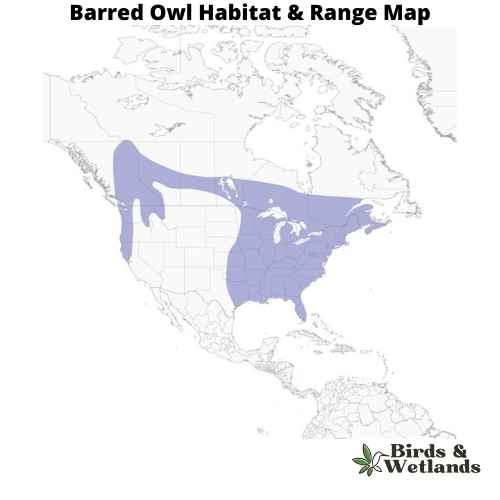
Barred Owl Sound
Scientific Name: Strix varia
Length: 40 to 63 cm (16 to 25 in)
Wingspan: 96 to 125 cm (38 to 49 in)
Weight: 468 to 1,150 g
The Barred Owl is a medium-sized owl with a barred pattern on its chest and belly. They have large yellow eyes that allow them to see well in low light conditions. Their ears are not very large which means they do not hear very well but they have excellent hearing abilities which allow them to detect sounds up to 1 mile away. Their feathers are brown and streaked with white, and they have black bars on their chests and wings.
Their habitats include forests, woodlands, orchards, parks, farmland and suburban backyards.
Barred Owls (also known as hoot owl) eat small mammals such as mice, rats and squirrels. They also eat insects such as beetles or grasshoppers. These owls hunt during the day when it is light out so that they can see their prey better than at night when they would be using senses other than sight like sound or smell to find their food source.
Barred owls are monogamous birds which means they mate for life. They build nests in trees or cavities on the ground and lay 2-4 eggs per year. The incubation period for these eggs lasts about 28 days before hatching takes place.
Boreal Owl (Aegolius funereus)
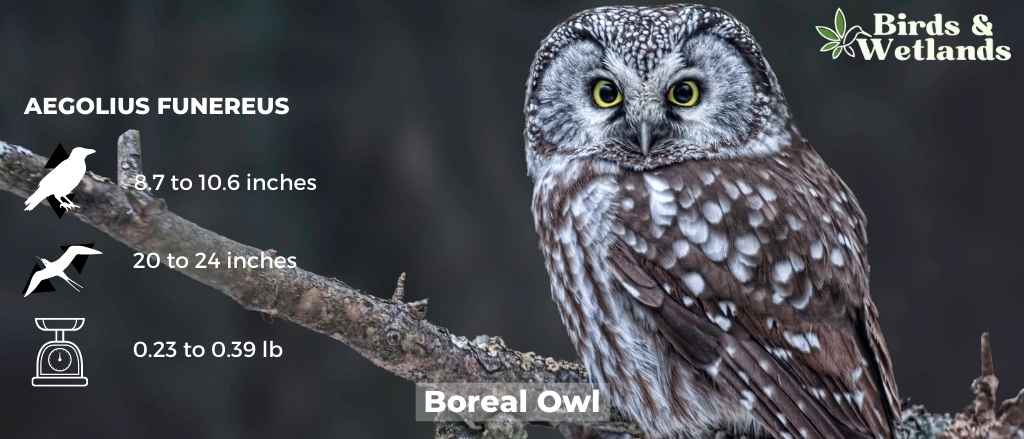
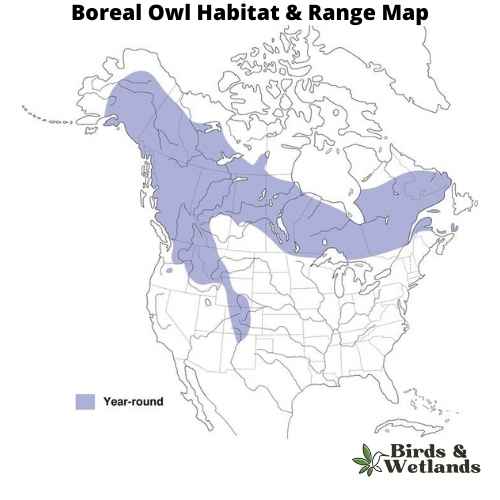
Boreal Owl Sound
Scientific Name: Aegolius funereus
Length: 8.7–10.6 in
Wingspan: 20–24 in
Weight: 3.8 oz–6.3 oz
The Boreal Owl, also known as Tengmalm’s Owl, is a small yet captivating nocturnal bird found predominantly in the northern hemisphere’s boreal forests, hence its name.
The Boreal Owl is petite in size, its plumage is predominantly grayish-brown, with white spots sprinkled on the upper parts and pale streaks on the underside, which lends a mottled effect. The bird’s rounded head, lack of ear tufts, and large yellow eyes are characteristic traits of this species.
Boreal Owls have a distinctive call, described as a series of soft, low hoots, which can often be heard during the cold winter months. As strictly nocturnal birds, they rest during the day, usually in tree cavities or similar concealed spots, and become active at night.
These owls are remarkable hunters, feeding mainly on small mammals such as voles and shrews, although they have been known to consume small birds when available. Their exceptional hearing allows them to locate prey under the snow in the darkest of nights.
Great Gray Owl (Strix nebulosa)
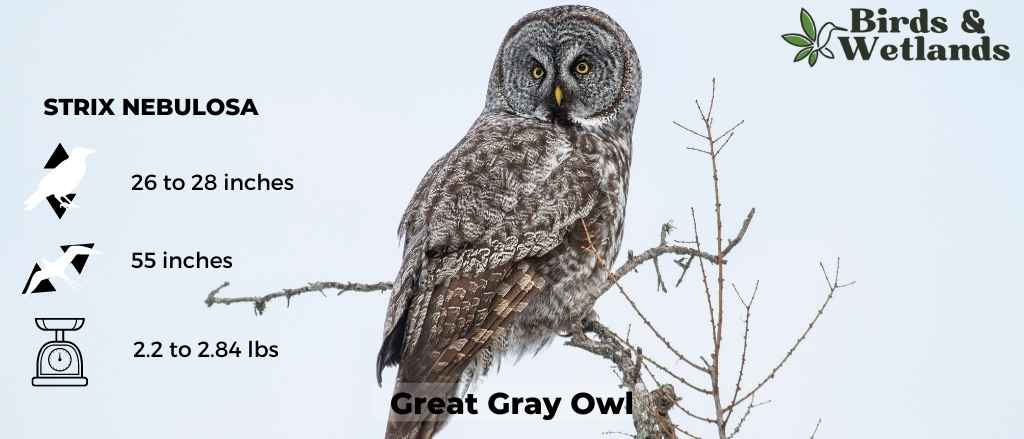
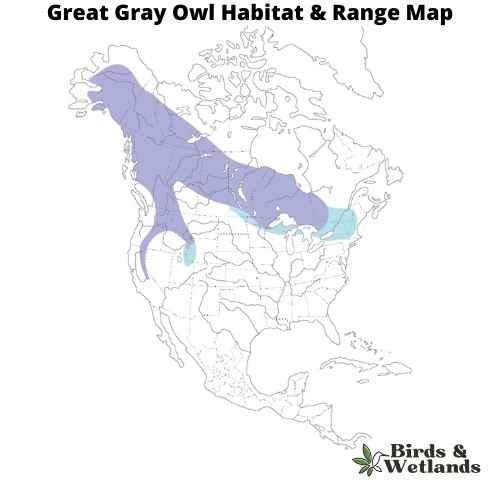
Great Gray Owl Sound
Scientific Name: Strix nebulosa
Length: 26 in to 28 in
Wingspan: 56 to 60 in
Weight:2.2 lb to 2.85lb
The Great Gray Owl, or Strix nebulosa, is a very large owl, native to the boreal forests across North America and Eurasia. Despite its great size, it’s more so known for its impressive appearance rather than its weight, as it is outweighed by several other large owl species.
The Great Gray Owl has a large, rounded head with a grey face and yellow eyes, surrounded by concentric circles of dark and light feathering. It is known for its bow-tie-shaped white moustache stripe and black chin spot.
One of the distinguishing characteristics of this owl is its elongated tail, which makes it appear much larger than it actually is. The plumage is mostly grey with a unique pattern of fine white, gray, and brown streaks and bars. Despite its large size, its diet primarily consists of small rodents, like voles and pocket gophers.
Great Gray Owls prefer dense coniferous forests, often near open meadows or bogs. Rather than building their own nests, they typically use nests previously built by other large birds, such as hawks or crows. They also occasionally nest in broken-top trees or on man-made structures.
Northern Hawk Owl (Surnia ulula)
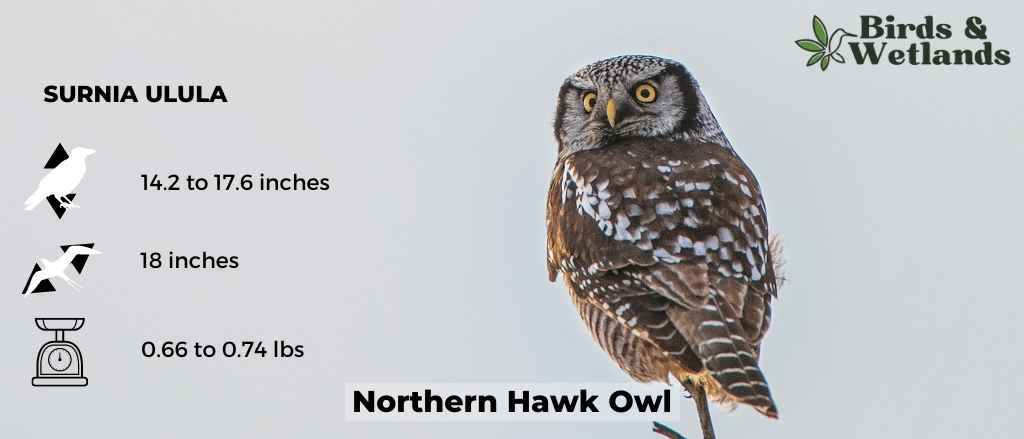
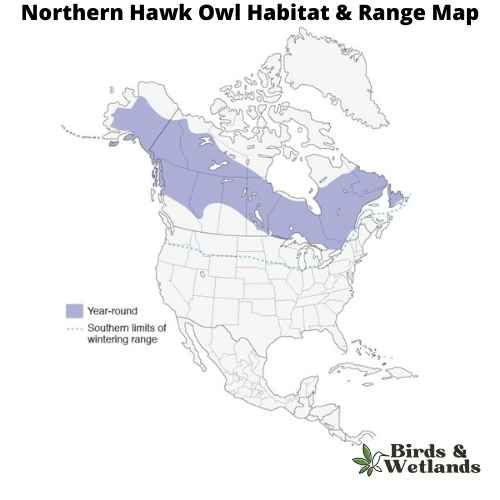
Northern Hawk Owl Sound
Scientific Name:Surnia ulula
Length: 14.2–17.6 in
Wingspan: 18 in
Weight: 11 oz-12 oz
The Northern Hawk Owl, is a medium-sized owl known for its daytime hunting habits and hawk-like behavior, hence its name.
Northern Hawk Owls are recognized by their elongated body, long tail, and lack of ear tufts – traits reminiscent of a hawk. Its plumage is generally dark brown, with white spots on the upper parts and streaks on the underparts. The owl’s face is marked by a white facial disc and distinctive black borders that make it appear somewhat masked.
Diet: consists of small mammals, such as voles, lemmings, and squirrels, but it has also been known to feed on smaller birds. The bird has an extraordinary vision that allows it to spot prey from up to 800 meters away, and it often hunts from a high perch, swooping down on its prey similar to a hawk.
Nesting typically occurs in tree cavities or abandoned nests of other birds. The female Northern Hawk Owl lays between 3 to 11 eggs and is responsible for incubation, while the male provides food and protection.
Great Horned Owl (Bubo virginianus)

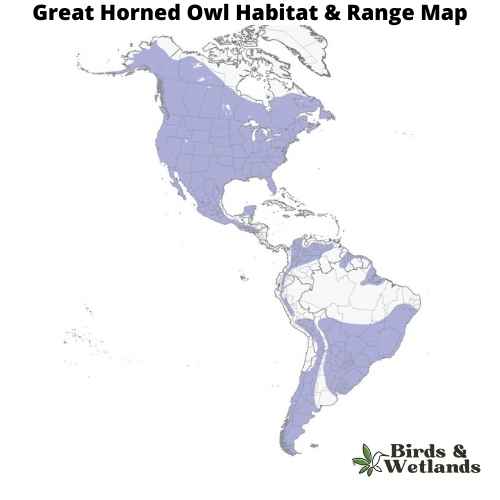
Great Horned Owl Sound
Scientific Name:Bubo virginianus
Length: 18.1-24.8 in
Wingspan: 39.8-57.1 in
Weight: 32.1-88.2 oz
The Great Horned Owl is a large owl with long wings and a large head. It’s one of the most common owls in North America.
Great Horned Owls are large, stocky birds with soft feathers that are gray to brown on their backs and white on their chests. Their faces are characterized by two black “ear” tufts, which can be raised or flattened depending on the owl’s mood. The eyes are yellow, orange, or red in color.
The habitat of the Great Horned Owl is a variety of different environments such as forests and deserts. They also live near water sources such as lakes, streams and rivers where they can hunt for fish.
The diet of the Great Horned Owl consists primarily of small mammals such as mice and rats; however they will also eat other rodents such as squirrels, rabbits and porcupines. They have been known to eat skunks too.
Northern Pygmy-Owl (Glaucidium gnoma)

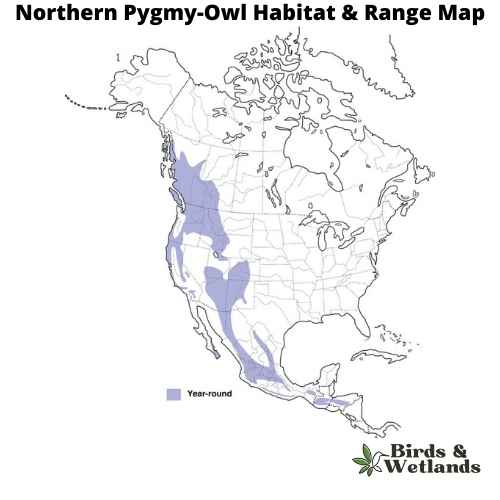
Northern Pygmy-Owl Sound
Scientific Name: Glaucidium gnoma
Length: 7 – 7 1/2 in)
Wingspan: 14.5 – 16 in
Weight: 62-73g
The Northern Pygmy-Owl is a small owl species native to North and Central America. Despite its small size, this owl is a fierce predator, known for its distinctive call and daytime hunting habits.
They have a rounded head without ear tufts and large yellow eyes. Their overall coloration is gray or brown with a pattern of white spots on the back and streaks on the front.
Northern Pygmy-Owls inhabit a range of habitats, including coniferous forests, deciduous woodlands, and mixed forests. They can be found at a range of elevations from lowlands to mountains. Unlike many other owl species, they are often active during the day, particularly in the early morning and late afternoon.
Their diet primarily consists of small mammals and birds, but they are also known to eat insects and reptiles. Despite their small size, they have been known to take prey up to three times their own size.
Northern Pygmy-Owls nest in tree cavities, often those created by woodpeckers. They do not build nests of their own but will add a few feathers to the cavity. Clutch size is usually around 2 to 7 eggs, which are incubated by the female while the male brings food.
Northern Saw-whet Owl (Aegolius acadicus)

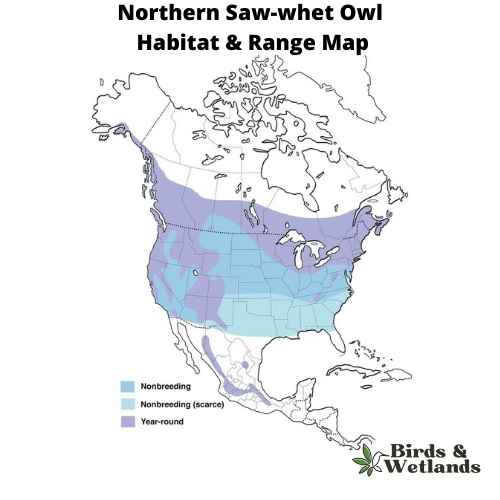
Northern Saw-whet Owl Sound
Scientific Name: Aegolius acadicus
Length: 17–22 cm (6.7–8.7 in)
Wingspan: 42–56.3 cm (16.5–22.2 in)
Weight: 54 to 151 g (1.9 to 5.3 oz)
The Northern Saw-whet Owl is a tiny, speckled gray owl and it’s one of the smallest owls in North America. It’s also known as the Little Owl or Wood Owl in some areas.
Northern Saw-whet Owls have dark brown eyes, white eyebrows, and yellow beak. It has brownish-grey feathers that are spotted with white. The owl’s legs are covered in feathers and appear nearly invisible when the bird is perched on a branch or tree.
In the winter they migrate south to warmer climates. They prefer to live in dense coniferous forest with large trees but will occasionally nest in shrubs or other vegetation that can protect them from predators.
The Northern Saw-whet Owl eats mice and voles (small rodents), small birds, frogs, salamanders, moles and shrews, but unlike most owls they chop their prey up and spread over a few meals. They will also eat insects like beetles and grasshoppers if they are available. It hunts from a perch at night using its excellent hearing to locate prey items within about 30 feet (9 meters) of its nest.
These owls nest in tree cavities usually located close to water sources such as lakes or rivers where they can find their food source (insects). They lay 2-4 eggs at one time which incubate for about 30 days before hatching.
Western Screech-Owl (Western Screech-Owl)
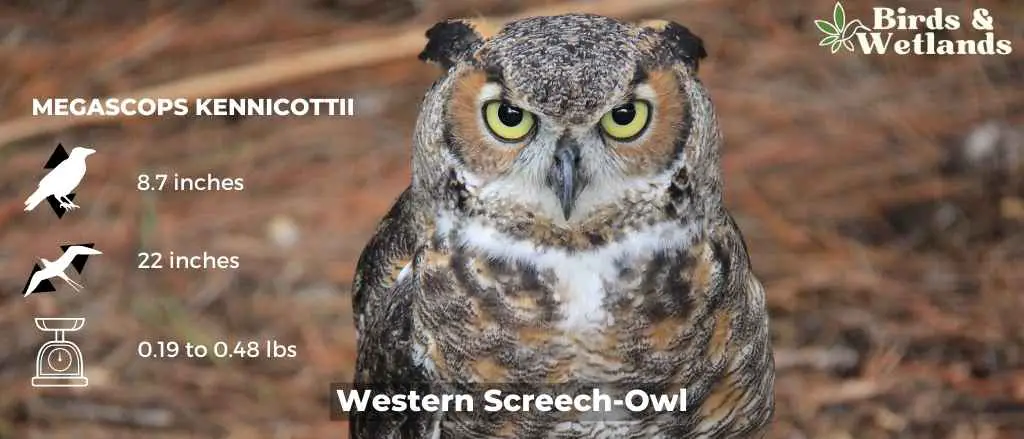
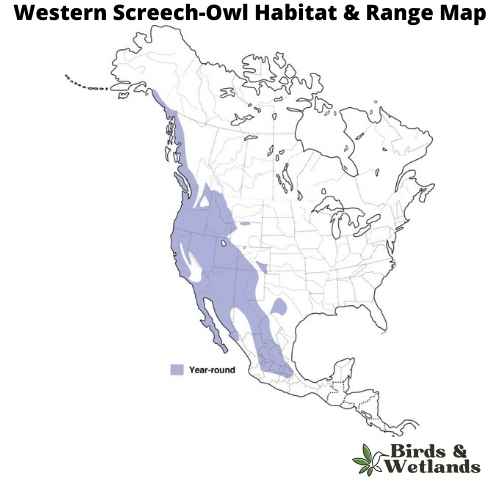
Western Screech-Owl Sound
Scientific Name: Megascops kennicottii
Length: 22 cm (8.7 in)
Wingspan: 55 cm (22 in)n
Weight: 88 to 220 g (3.1 to 7.8 oz)
The Western Screech-Owl, or Megascops kennicottii, is a small species of owl native to North and Central America. Western Screech-Owls are nocturnal predators, and its diet primarily consists of small mammals, birds, insects, and occasionally fish.
This owl is medium-sized compared to other screech-owls. It has a compact, stocky body, and is often recognized by its large head with yellow eyes surrounded by greyish-brown facial disks. The plumage is generally a mixture of grey and brown, with intricate patterns of spots and streaks that provide excellent camouflage against tree bark.
These owls prefer mixed woodland habitats, including deciduous forests and semi-open areas with trees. They often nest in tree cavities, but will also readily take to nest boxes if available. These birds are primarily non-migratory, and once they’ve established a territory, they tend to stay within the same area year-round.
Short-eared Owl (Asio flammeus)


Short-eared Owl Sound
Scientific Name: Asio flammeus
Length: 13–17 in
Wingspan: 33 to 43 in
Weight: 7.3–16.8 oz
The Short-eared Owl is a medium-sized owl species with a wide distribution, found across North and South America, Europe, Asia, and many Pacific islands. Despite its name, the “ears” of the Short-eared Owl are not often visible, as they are small and tend to blend with the bird’s feathers.
The owls are predominantly brown with buff and white accents throughout their body and wings, and dark patches around their yellow eyes.
Short-eared Owls diet consists largely of small mammals, especially voles. However, they are opportunistic hunters and will also prey on a variety of other animals, including other birds, when available.
Their habitat is characterized by open areas like grasslands, marshes, and tundra. They nest on the ground, which is unusual for owls, and this makes them vulnerable to ground predators. As such, they often live in areas with tall grasses or other ground cover for protection.
Snowy owl (Bubo scandiacus)
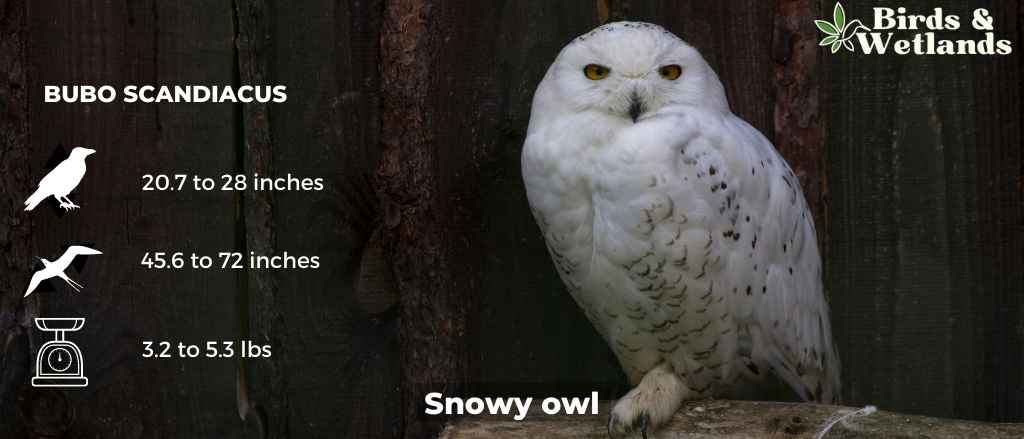
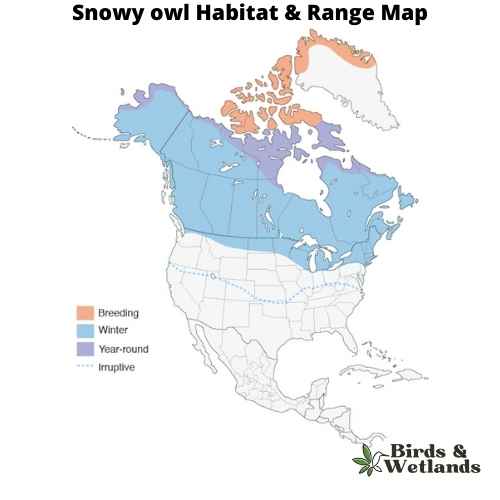
Snowy owl Sound
Scientific Name: Bubo scandiacus
Length: 20.7 to 28 in
Wingspan: 3 ft 10 in to 6 ft 0 in
Weight: 3.2lb to 5.3lb
The Snowy Owl, is of the most well-known species of owls, the Snowy Owl is renowned for its striking appearance and adaptations to its extreme environment.
Snowy Owls are medium sized birds that possess a rounded head, yellow eyes, and a black beak. The most distinctive feature of the Snowy Owl is its white plumage, which provides effective camouflage in its snowy habitat. Male Snowy Owls are often almost completely white, while females and younger owls have more extensive dark barring on their plumage.
Unlike many owl species, Snowy Owls are primarily diurnal, which means they are active during the day. This is an adaptation to life in the Arctic, where there can be 24 hours of daylight in the summer. Their diet mainly consists of small mammals, particularly lemmings, but they are known to eat a variety of animals including birds, fish, and even carrion when necessary.
Snowy Owls nest on the ground, usually on a mound or boulder. Their breeding success is closely tied to the availability of food, and in good years a single pair of owls can raise a large brood of chicks.
How to spot Owls in Alaska?
Spotting owls in Alaska can be an exhilarating experience, though it often requires patience, awareness, and a few essential tips:
- Know the Time: Owls are primarily nocturnal creatures. They are most active during dusk and dawn, so plan your bird watching adventures around these times for better chances of sighting.
- Understand the Seasons: Owl activity varies with the seasons. For instance, Snowy Owls migrate to the tundra region during the summer, while autumn is a good time to spot owls like the Great Gray as they become more vocal during mating season.
- Learn Owl Calls: Understanding different owl hoots can help you locate these birds. There are online resources and apps available to learn about the distinctive sounds made by different owl species.
- Look for Owl Signs: Look for signs of owls, like whitewash (owl droppings) and pellets, under trees. Feathers and scattered bones from their prey can also indicate the presence of owls.
- Use Binoculars or a Telescope: Owls are often camouflaged and may perch at a distance. Quality bird-watching binoculars or a telescope can make spotting them easier.
- Stay Quiet: Owls have acute hearing and can be easily scared off by noise. It’s essential to keep your movements slow and your volume down to avoid scaring them away.
- Join a Guided Tour: If you’re new to bird watching, joining a guided tour can be highly beneficial. Experienced guides can offer insights about owl behaviour, preferred habitats, and identification tips.
| Owl Species | Presence in Alaska | Specific Habitats |
|---|---|---|
| Great Horned Owl | All year | Forest edges, woodlands, and open areas |
| Boreal Owl | All year | Boreal forests and high-altitude woodlands |
| Northern Pygmy-Owl | All year | Mixed forests, especially near edges and clearings |
| Snowy Owl | Summer | Arctic tundra and open landscapes |
| Northern Hawk Owl | Winter | Open tundra and boreal forests |
| Northern Saw-whet Owl | Winter | Mixed forests, especially near edges and clearings |
| Great Gray Owl | Winter | Dense forests and woodlands |
| Short-eared Owl | During migration | Open grasslands and wetlands |
| Western Screech-Owl | Rare or accidental | Old growth forests and dense woodlands |
| Long-eared Owl | Rare or accidental | Dense groves of trees near open areas |
| Flammulated Owl | Rare or accidental | Montane forests, especially areas with old, large trees |
Remember, owls are protected species. Always observe them from a distance, respect their habitats, and never disturb nesting sites. Happy owl spotting!
Where to Spot Alaska’s Owls
Denali National Park: This vast wilderness hosts a diverse range of owls including the Boreal Owl, Great Horned Owl, and the Northern Hawk-Owl. The Park’s expansive boreal forests and untouched tundra are ideal for bird watching.
Tongass National Forest: Located in the Southeast, it’s a haven for Barred Owls and Western Screech-Owls. The dense old-growth forest and diverse habitats make it a paradise for avian enthusiasts.
Fairbanks and Interior Region: Known for its sightings of the majestic Great Gray Owl, this region also offers a glimpse of the Northern Hawk-Owl. The boreal forests surrounding Fairbanks are prime owl-spotting territory.
North Slope and Barrow: This is the place to be if you want to witness the regal Snowy Owl in its natural tundra habitat. The open landscapes provide fantastic bird watching opportunities.
Matanuska-Susitna Valley: Close to Anchorage, this valley is home to the Great Horned Owl, making it a popular spot for local birdwatchers.
FAQs on Owls in Alaska
What is the most common owl in Alaska?
he Great Horned Owl, for instance, is a common species across the state. This adaptable bird lives in many habitats, from forests and mountains to deserts.
What kind of owls do we have in Alaska?
Other owl species found in Alaska include the Snowy Owl, Northern Hawk Owl, Boreal Owl, and Northern Saw-whet Owl, amongst others. Other owls rarely spotted in Alaska include Northern hawk owls though they are mainly Canada based. Northern hawk owls nest in dense forests and these owls hunt at night. See our complete guide to birds of prey in Alaska or our Alaskan bird species page for all birds.
How many species of owls are in Alaska?
9 Common 2-3 rare infrequent visitors
Do great GREY owls live in Alaska?
Yes, the Great Grey Owl does indeed inhabit Alaska. This species, known for its large size, distinctive facial disc, and “bow tie” marking below the beak, can be found in the boreal forests of Alaska. It’s one of the most iconic and admired owl species in the state. Please note that species presence can vary year-to-year due to environmental factors, migration patterns, and other influences.


